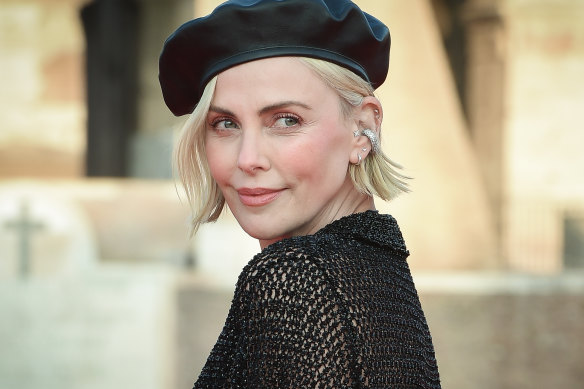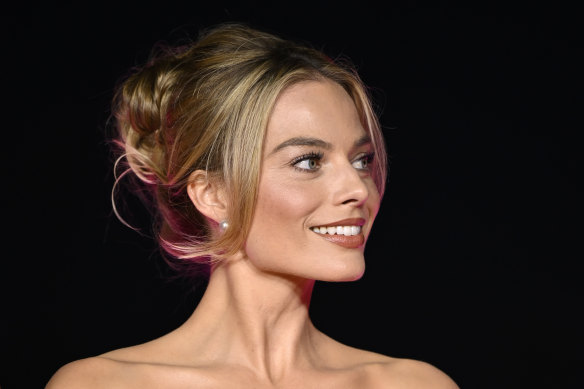By Rachel Tashjian
What does it mean to “look your age”?
In a recent story published by Allure, Charlize Theron addresses a reality that few people in Hollywood want to face: she is, in fact, getting older.
Discussing the new imagery from her run of two decades and counting as the face of Dior’s J’Adore perfumes, she said that the succession of campaigns is like a yearbook that shows the ways she has grown and aged – but that many people seem to think these natural changes are the unfortunate results of plastic surgery.

Charlize Theron, 48, at the world premiere of Fast X in May, 2023.Credit: Getty
“My face is changing, and I love that my face is changing and ageing,” she told the magazine, but “people think I had a facelift. They’re like, ‘What did she do to her face?’ I’m like, ‘B----, I’m just ageing! It doesn’t mean I got bad plastic surgery. This is just what happens.’”
It seems likely that Theron also has a fantastic dermatologist and fabulous skincare products on her side, but the actress brings up a point of significant confusion at a time when the only things more available than cosmetic injectables are social media filters. What does a 48-year-old woman look like now? Are 82-year-olds all supposed to look like recent Sports Illustrated Swimsuit cover model Martha Stewart? And what about being in your late 20s or early 30s, when your face begins to look more adult? What does “more adult” mean when anyone can pay to give themselves the smooth, immobile face of the moment?
In other words: what does it look like to age?
Theron’s face is not the only one the internet picks apart. During press tours this summer, both Jennifer Lawrence (promoting her comedy No Hard Feelings) and Margot Robbie (the titular star of Barbie), both in their 30s, were frequent topics of discussion on skincare TikTok and Instagram. Though it isn’t hard to imagine that they, too, have the usual arsenal of Hollywood specialists and pricey creams and treatments on their side, people often suspect they have had much more than Botox, lasers and peels done.
Accounts such as @celebrityplastics and @igfamousbydana use their self-taught expertise and tips from anonymous sources to explain the extensive surgeries and modifications stars allegedly undergo. “She has had an upper bleph ([especially] removing some fat under her brow), undereye filler or other augmentation, a minimal brow lift, cheek augmentation, buccal fat removal, lip filler, nose job thinning her tip and reducing the width of her nostrils,” reads a post by @igfamousbydana’a founder, Dana Omari-Harrell, on Robbie.
“There are some people that I’ve actually seen or treated myself personally,” says Shereene Idriss, a New York-based dermatologist who works with celebrity clients and who provides skincare advice on TikTok and Instagram. “More often than not, [the video] is not correct.”

Margot Robbie, 33, is the subject of online scrutiny around cosmetic surgery and injectables.Credit: Getty
The confluence of celebrity culture and the ability to manipulate every casual selfie has created the sense that we are not meant to look old at all.
These images have “warped the way people think about ageing, and what is considered to be quote-unquote ‘normal,’” Idriss says. “Unfortunately, I do attribute it to all these social media filters. All these people who are getting work done who look just ambivalent. They don’t look like anyone; they just look like everyone.”
“It has taken away from the beauty that comes with ageing,” Idriss adds. “People can age gracefully, but people no longer know what that looks like.”
Linda Wells, who founded Allure in 1991 and now edits Air Mail’s beauty publication, Look, lived through the great debates about magazine retouching in the 1990s and 2000s. Fashion magazines have always used retouchers to create a sense of fantasy beyond what’s possible in real life, but “retouchers existed the minute photography was born”. Editing or manipulating a photograph, or even asking a friend to retake that selfie so you can tilt your head to a slightly more flattering angle, “is a human impulse,” Wells says.
Now, though, “I think the tools are in the hands of individuals who aren’t professionals, so it seems like it has the potential to run amok. And it changes what everyone’s perception is,” she says. “We all look at these pictures and think, ‘OK, well, it’s not true, but then again, what is?’”
Undoubtedly, people do look much younger now than they did in previous decades. The standard-bearers may be unrealistic: 50-year-old Gwyneth Paltrow with her abs, or Stewart in her sultry swimsuit cover.
But a look back at stars from films in the 1950s, ’60s or ’70s – and even into the early 2000s – shows how health and our own standards of physical maintenance have improved. Developments in sunscreen, the introduction of retinol, and the decline in hazardous habits such as smoking cigarettes, mean that people look younger. (Idriss herself is the frequent recipient of such comments; she is 39, but TikTok commenters often say she looks 10 years younger than that, or more.)
When Botox was approved for cosmetic use in Australia by the Therapeutic Goods Administration in 2002 it was intended to soften lines on the face. Now, many patients (and doctors and nurse practitioners) see an immobile face as the goal.
Wells says the frozen look was once widely mocked – but now, Instagram and TikTok filters that shrink your nose, widen your eyes and clear your skin (features included even when the filter is as anodyne as putting a cowboy hat on your head) have led young women to “this belief that an un-animated face will never become wrinkled. So expressionless-ness and frozen means you’ll prevent wrinkles forever and ever - which is not possible”.
The Kardashian women are perhaps the epitome of this look. On their eponymous TV show The Kardashians, streaming on Disney+ in Australia, Kim jokes about the amount of Botox she uses, and the sisters speak in a monotone, flat voice that seems as affectless as their expressions.
It may be related that the demand for injectables spiked during the pandemic, when we were forced to stare at our faces on Zoom and see our reactions as our colleagues see them.
“Beauty is always about control,” Wells says. “The world of beauty is always about controlling nature, which is not controllable, although it gives us the myth of control.”
Both Wells and Idriss say the goal for many women remains ageing gracefully – which is to say, ageing in a way where you look like yourself. Some of Idriss’s clients who work in entertainment have even asked her not to address issues that might be seen as flaws. “They’ve all seen their colleagues look weird at a certain point,” she says. “I do think the pendulum is swinging back to a world that is more realistic and not so unattainable.”
Frequently, Idriss says, the answer to patients’ questions about ageing is not Botox or fillers; it’s developing a routine that addresses the quality of your skin tone, more than lines or sagging.
“I think ageing is a beautiful thing,” she says. “I think if you’re not ageing, you’re dead. The goal is to age as beautifully as you want to, for yourself.”
Washington Post
Make the most of your health, relationships, fitness and nutrition with our Live Well newsletter. Get it in your inbox every Monday.